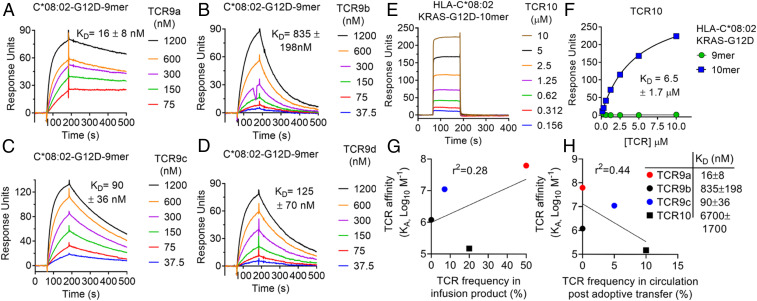BIOPHYSICS AND COMPUTATIONAL BIOLOGY Correction for “High-affinity oligoclonal TCRs define effective adoptive T cell therapy targeting mutant KRAS-G12D,” by Malcolm J. W. Sim, Jinghua Lu, Matthew Spencer, Francis Hopkins, Eric Tran, Steven A. Rosenberg, Eric O. Long, and Peter D. Sun, which was first published May 27, 2020; 10.1073/pnas.1921964117 (Proc. Natl. Acad. Sci. U.S.A. 117, 12826–12835).
The authors note, “In Table 1 and Fig. 3 G and H, the frequencies of TCR9b and TCR9c in the TIL infusion and in the periphery were inadvertently switched. The correct frequencies of TCR9b and TCR9c results in an inverse correlation between TCR affinity and in vivo persistence with r2 = 0.44, which is lower than published. In addition, three sentences in the Abstract and Discussion are revised to be consistent with the correction.
Table 1.
KRAS-G12D–specific T cell receptors
| Patient no. | TCR name | V alpha | V beta | CDR3α (length) | CDR3β (length) | TCR frequency (infusion), % | TCR frequency (post transfer), % | KRASG12D specificity |
| 4095 | 9a | TRAV4*01 | TRBV5-6*01 | CLVGDMDQAGTALIF (13) | CASSLGEGRVDGYTF (13) | 50 | 0 | 10GADGVGKSA |
| 4095 | 9b | TRAV4*01 | TRBV5-6*01 | CLVGDMDQAGTALIF (13) | CASSLGRASNQPQHF (13) | 0.04 | 0.005 | 10GADGVGKSA |
| 4095 | 9c | TRAV4*01 | TRBV5-6*01 | CLVGDRDQAGTALIF (13) | CASSFGQSSTYGYTF (13) | 7 | 4.5 | 10GADGVGKSA |
| 4095 | 10 | TRAV12-2*01 | TRBV10-2*01 | CAAAMDSSYKLIF (11) | CASSDPGTEAFF (10) | 20 | 10 | 10GADGVGKSAL |
| 3995 | 9d | TRAV4*01 | TRBV5-6*01 | CLVGDMDQAGTALIF (13) | CASSLGQTNYGYTF (12) | 0.002 | 0 | 10GADGVGKSA |
Fig. 3.
KRAS-G12D–specific TCRs display high affinities that inversely correlate with in vivo persistence. (A–D) Binding of TCR9a (A), 9b (B), 9c (C), and 9d (D) to captured HLA-C*08:02–KRAS-G12D-9-mer at the indicated nanomolar concentrations determined by surface plasmon resonance. Dissociation constants were determined by kinetic curve fitting. Data are representative of two independent experiments. (E) Binding of TCR10 to captured HLA-C*08:02–KRAS-G12D-10-mer at the indicated micromolar concentrations determined by SPR. Data are representative of three independent experiments. (F) Equilibrium binding and affinity (steady state) of TCR10 to HLA-C*08:02–KRAS-G12D-10-mer and KRAS-G12D-9-mer. Data are representative of three independent experiments. (G and H) Correlation of TCR affinity (KA) with TCR frequency in the infusion product used to treat patient 4095 (G) and in the periphery of patient 4095, 9 mo after T cell transfer (H). TCR frequencies are from ref. 17.
“On page 12826, the text in the Abstract that states ‘Intriguingly, TCR binding affinities to HLA-C inversely correlated with their persistence in vivo, suggesting the importance of antigenic affinity in the function of therapeutic T cells’ should instead read ‘Intriguingly, the highest and lowest affinity TCRs exhibited inverse persistence in vivo, suggesting their antigenic affinity impact the persistence of therapeutic T cells.’
“On page 12832, right column, second full paragraph, the text that states ‘Limited of course by the number of TCRs studied from this case, we nonetheless observed that TCR frequency post adoptive transfer was inversely correlated with TCR affinity. Specifically, those TCRs with lower affinity (TCR9b and TCR10) had the highest frequencies’ should instead read ‘Limited of course by the number of TCRs studied from this case, we nonetheless observed a weak inverse correlation between TCR post adoptive transfer frequencies and their affinities. Specifically, the lower affinity TCR10 had the highest frequency.’
“We apologize for this oversight.” Table 1 and Fig. 3 have been updated and appear below.



